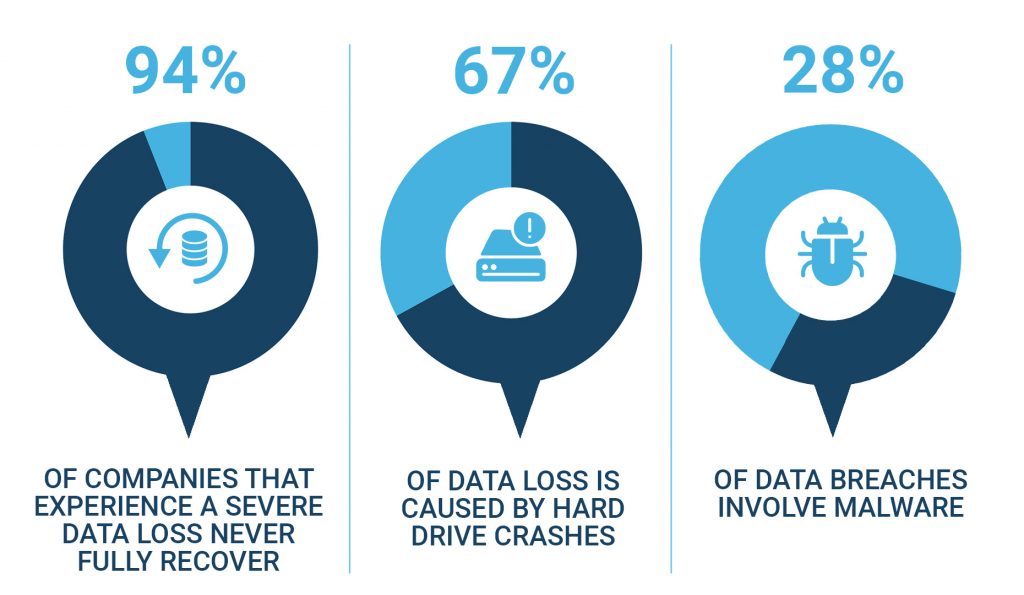Picture this: You switch on CNN to watch the morning news, and the headlines read: “Tech Giant’s Cloud Outage Sparks Chaos – Millions of Users Left in Digital Limbo.” Overnight, a leading cloud provider’s infrastructure falters, causing widespread data loss for countless businesses that rely on their services. Financial records, customer databases, and crucial business operations vanish, revealing the harsh reality of a world where data vulnerability can bring even the mightiest to their knees.
This alarming scenario once again underscores the undeniable necessity of a robust backup and disaster recovery strategy for any enterprise operating in the digital space.
Data loss is one of the most common causes of business disruption today, and its consequences are so significant it can sink your business. It’s estimated that up to 94% of companies that experienced a severe data loss never fully recover. Data loss is a nightmare no business leader wants to face. It’s unexpected, it’s frustrating, and it can be incredibly costly. And in the case of a large-scale data-loss event, like a ransomware attack, the recovery costs can sometimes be insurmountable.
The good news is that with the right backup and disaster recovery strategy, you can keep your business afloat and avoid the bitter taste of regret due to data loss.
But what causes data loss, and how can you safeguard your business? In this blog we’ll dive into the most common causes of data loss, the true cost of data loss, and why you can’t afford to ignore it.
What Are the Most Common Causes of Data Loss?
Data loss can happen in a number of ways, and businesses should familiarise themselves with the most common causes. By so so, they can implement effective cloud backup and disaster recovery strategies and, in all likelihood, prevent data loss in the first place. Here are the most common causes of data loss:
- Hardware failures: It might surprise you to learn that hardware failure is a prime culprit in data loss scenarios. This could involve issues with hard drives, servers, or other tangible computer elements. Studies indicate that up to 50% of hard drives fail every five years. It’s not about “if” it will happen, but rather “when”.
- Human error: To err is human, but it’s unfortunately also the second most common cause of data loss. This can include mistakenly deleting files, overwriting them, or misplacing devices that store data.
- Malware and cyberattacks: Malware and cyberattacks are becoming increasingly common causes of data loss. Ransomware and other forms of malware can encrypt or delete data, while cyberattacks can result in data theft or destruction.
- Software issues: Software-related problems such as system crashes, or corruption can also trigger data loss.
- Natural disasters: While less common, natural disasters such as floods, fires, and earthquakes have also made the list of incidents that can cause data loss.
- Theft or loss of devices: Losing a device or having one stolen is another path to potential data loss.
- Power failures: Power failures can cause data loss if files are not saved properly.
Understanding the Full Cost of Downtime as a Result of Data Loss
When most people think about the cost of downtime, they usually consider lost revenue or maybe a mix of lost revenue and worker productivity. But the reality is the impact of downtime goes much further.
Research from the independent data protection and security firm, Ponemon revealed that the biggest chunk of downtime cost comes from business disruption. This includes things like damage to a company’s reputation and loss of customers. The second largest cost was lost revenue, followed by reduced end-user productivity.
Another common area of loss is the internal productivity of the IT team, who have to fix the issue, as well as other teams involved in managing the incident, such as PR, social media managers, and customer service reps.
Software providers face real financial drains in the form of penalties for not meeting Service Level Agreements (SLAs), government fines if they breach any regulatory requirements, and litigation and settlements. For companies that deal in physical products, a significant risk is running out of stock.
And let’s not forget the costs associated with hiring contractors, replacing equipment, and dealing with employee retention issues. After all, incidents cause stress, which leads to unhappy employees, and unhappy employees tend to leave.
So, as you can see, the costs associated with downtime can add up quickly and impact more than just revenue and productivity.
The Power of an Effective Backup and Disaster Recovery Plan
Data loss can be devastating for businesses, no matter the size. The cost of downtime can vary depending on the size of the company, but it can range from $10,000 per hour to more than $5 million per hour. Businesses can be financially devastated by the cost of missed sales, damaged customer trust, and recovery processes. Even large enterprises like Amazon have lost millions in revenues due to outages.
A robust backup and disaster recovery strategy is a company’s best defense against the high cost of data loss. It ensures that critical data is backed up regularly and can be quickly restored in the event of a disaster.
Even though data backups are critical, they need to be part of a larger business continuity strategy. Businesses that properly plan for data loss can greatly reduce the cost of such incidents when they occur. Important components of a business continuity strategy include:
- Cloud backup: Regularly back up your data using, for example, public cloud storage. But remember, the public cloud is not the be-all and end-all – your public cloud data is fragile and can also fall victim to downtime, ransomware attacks and data loss. You still need a backup and disaster recovery solution that includes resilience, redundancy, ransomware protection, and recoverability between multiple cloud platforms. This will give you the freedom and peace of mind that you can recover from any cloud to any cloud, plus your data will always be available despite disruptions and disasters.
- Disaster recovery plan: This plan should include both preventive measures to avoid disasters and detective measures to identify potential issues that could be overlooked. A good disaster recovery solution makes restoring your data and workloads easier, helping your business operations get back up and running in no time after a major incident.
- Regular testing: It’s crucial to test your disaster recovery plans routinely to confirm they work as intended. Conducting practice drills helps gauge the plan’s effectiveness, and should you discover any elements that don’t function well in real-world scenarios, you can make the necessary adjustments.
- Documentation: All disaster recovery plans need to be properly documented and updated regularly. This ensures their ongoing relevance and effectiveness.
- Risk assessment: Understanding the risks your business could face is vital. Once you’ve identified these risks, you can develop a disaster recovery strategy tailored to tackle them.
Final Thoughts
Data has become the lifeblood of most organizations. It fuels decision-making, drives operations, and is at the heart of customer engagement. That’s why it’s crucial to partner with a cloud service provider who understands this and offers a versatile backup and disaster recovery strategy that ensures that even in the public cloud, your data is protected from loss, ransomware, and is disaster resilient.
Cloud Provider Resiliency (CPR™) offers resilience, redundancy, and recoverability across multiple cloud platforms so you can recover your data from any cloud to any other cloud. With CPR™, your public and private cloud data and virtual machines are securely replicated and stored in Stage2Data’s private cloud. This ensures you can recover your data from disruptive events, like hardware failures, power outages, unexpected demand surges, software failures, and cyber-attacks, with minimal to no service disruptions.
By offering secure replication, storage, smart recovery, and CPR™ we help businesses like yours mitigate the risk of data loss and minimize the impact of disruptions on your business operations.
To see how we can help you prevent data loss, get in touch.






